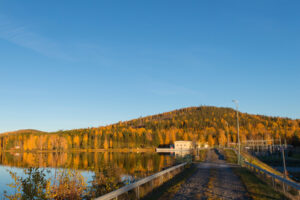Meeting the world’s increasing need for energy without continuing the dependency on fossil fuels such as oil, coal and natural gas is one of our greatest challenges. The Swedish business- and research community has a long tradition of collaboration, which has made Sweden a global leader in developing the solutions needed for a low-carbon economy. For instance, Sweden holds the lowest share of fossil fuels in its primary energy supply among all IEA member countries.
The energy production in Sweden is known for its reliable delivery and cheap price. Thanks to well-developed hydropower, in combination with extensive district heating and cooling systems, Sweden has been able to make the switch to renewable sources of energy at a high pace. The quick need to switch to renewable energy has resulted in innovative solutions, such as solutions for de-icing wind power turbines and data management for planned stoppages. More novel techniques such as wave energy are also currently in development.
But sustainable energy production does not solely mean producing power, it can also imply reusing energy through energy recycling. Sweden has converted waste streams to energy, mainly through the national system for waste management and cogeneration plants for decades. In this way, expertise in the circularity of material flows has been developed, creating better opportunities for more sustainable energy production.
Sweden has a variety of innovative businesses working in the field of sustainable energy production, with an emphasis on developing high-tech components for wind power, solar power, indoor light power, and wave power.
The future
Sweden, like many other countries, is in a transition phase from the use of nuclear power towards renewable energy. One difficulty with this conversion is how renewable energy naturally fluctuates in energy output. When energy is not generated by wind or sun, other sources of energy need to be used. To fully rely on renewable energy, the development of flexible energy production, demand-side flexibility in consumption, increased energy storage capacity, and smart grids will become increasingly important.

Image by Rikard Lagerberg/imagebank.sweden.se
A traditional way of increasing flexibility in electricity generation is done through hydropower plants pumping and storing water. When electricity demand increases and the supply of renewable energy decreases, the stored water can be used to generate electricity as a demand response. This means better aligning the often-variable renewable energy supply with electricity demand patterns. Similarly, this flexibility can also exist on the demand side with, for instance, consumers heating their water and charging their electric car when electricity is abundant and cheap.
Storage capacity is also an area that will see a large-scale change in the future, especially given the increased use of renewable energy sources. Historically, storage hasn’t been a favourable solution given the energy losses involved in the process. Innovative and disruptive technologies for storage without the associated energy loss are currently under development. Finally, smart grids, with the possibility to switch between different types of renewable energy sources, will also become increasingly important in the future.
1900’s-1950’s: Vast expansion of hydropower plants in northern Sweden.
1980’s: Landfill gas was the first type of biogas to be extracted from waste.
1990’s: Biodegradable kitchen waste started replacing landfill gas for biogas production.
2000’s: Green tax switching policies were introduced in Sweden, furthering the shift from fossil fuel to non-fossil fuel. The result was that coal became replaced with biofuels in Swedish cogeneration plants.
2000’s: Implementation of the electric certificate system, which promotes sustainable energy production.
2018: Building of the Swedish battery company Northvolt’s test lab in Västerås.
2019: Sweden opened its frequency Containment Reserve making it possible for energy customers to sell their flexible energy consumption to the grid. This means that small scale energy producers can sell their energy to the grid so that the grid can maintain 50hz, which it needs in order to function properly.